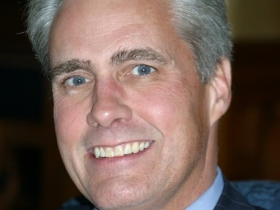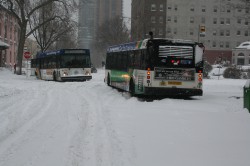County Transit Applicants Sell Themselves to — Huh?– the City
Just to further mess up a murky issue, the companies' often sketchy presentations were made to a city committee, not to the county.
In an unusual twist, two bidders for the management and operation of the Milwaukee County Transit System made presentations to a city committee Friday morning despite the fact that the city can’t award the contract and the county executive has already announced his intent to award it to one of the firms. County Executive Chris Abele previously announced his intent to award the Milwaukee County Transportation System management contract to MV Transportation, but actions from other bidders suggest they believe the contract is far from a sure thing for MV.
Appearing before the city’s Public Transporation Review Board were Veolia Transportation and MV Transportation. According to board chair Ald. Robert Bauman, existing MCTS operator Milwaukee Transport Services declined to make a presentation on advice from their legal counsel.
The Public Transportation Review Board is a fairly new city committee. It was formed in the summer of 2011 (by sponsor Ald. Jim Bohl), broadening the focus of the prior Taxicab Review Board. Bauman, the only alderman on the board, uses the committee as a vehicle to generate public, on-the-record discussion on transportation issues despite the board’s lack of official oversight. The recent decision to raise the cap on taxicab permits in Milwaukee by 100 licenses started with public hearings before the board. In addition, Bauman has used the board as a vehicle to get updates on Clear Channel’s ownership of MCTS bus stops, the Milwaukee Intermodal Station’s train shed updates, the now cancelled Talgo trainset maintenance facility and the American Civil Liberties Union’s lawsuit against WisDOT for the Zoo Interchange reconstruction.
Like much of the debate on this issue of the county transportation system, details remained scant throughout both presentations, but both firms spoke of their success in other cities and with new technology. Veolia went first, and their presentation was similar to two it gave last week at Transfer Cafe and Coffee Makes You Black (Urban Milwaukee promoted these discussions by publishing a Veolia press release, but is not endorsing Veolia or any firm’s proposal). Michael Setzer began the presentation by noting that the firm focuses on mobility beyond just the bus, and repeatedly use the analogy of Dell vs Apple. He noted that Dell makes a machine that works, but Apple continually innovates with new services. He said Veolia operates service on six continents, and has 150 locations in North America and his presentation focused on success stories in Nassau County (Long Island, New York) and New Orleans (where the firm gains the distinction of being the largest streetcar operator in the United States).
He noted that the firm provides service to Phoenix, Las Vegas, Denver, and many other cities. In Wisconsin, they provide a single employee to Waukesha Metro Transit in a management capacity.
MV Transportation came next. The presentation by its VP of Communications Nikki Frenney-Wiggins spoke more directly to Milwaukee and less about other cities. It was still scant on specifics though. She said the company may implement an undercover officer program on the bus (utilizing Milwaukee police officers) similar to the Air Marshall program. Bauman pressed for details on this program, but was rebuffed on specifics. Bauman noted that such a program would be quite expensive, and that MV was not noting a way to pay for this.
Frenney-Wiggins said she believed MV won the contract because of the amount of funds it proposed to dedicate to operations from the $164 million budget. Both firms have noted that the structure of the request for proposals by Milwaukee County was unusual in that it requested applicants to specify how they would spend the $164 million.
She also noted MV’s desire to use the defunct Transit TV system(the disabled displays only remain on a small minority of buses) to communicate with riders and offer advertising, thereby maximizing revenue opportunities. MV claimed that 80 percent of riders miss Transit TV. Bauman (and this author) strongly disagreed.
Speaking from the position of having won the RFP process, she said MV will offer every union employee a job. Also, their proposal includes incentive payments for things like on-time performance, which they would share with drivers.
Perhaps the most interesting statement by Frenney-Wiggins is that MV doesn”t expect to generate much, if any, profit from their Milwaukee operation. They instead hope to use the Milwaukee deal to help them win more contracts elsewhere and thereby bolster their buying power, allowing them to reduce costs company wide.
At the end of their presentation, following a question from Bauman, the MV representative noted that it’s possible the company would hire the existing top MTS employees as employees of MV. Bauman said he was concerned about MV’s plan of bringing in Green Bay transit system manager Tom Wittig to manage the Milwaukee system because of his lack of big city experience.
For both firms, the Milwaukee County Transit System would be their largest fixed-route transit system. Both mentioned their buying power as large transit operators (each with annual revenues in excess of $1 billion, Veolia being the largest by a couple hundred million) that could yield efficiencies. They also stressed their strategy of using the appropriate buses on the appropriate routes, something that MCTS has moved away from by standardizing their fleet.
Both firms also stressed their desire to use their own real-time information software, something MCTS is already working to implement.
What’s Next?
The logical next step in the process is for the lawsuits regarding the process to play out in court. The County Board also formed a months delayed appeal committee following inquiries by Urban Milwaukee Editor Bruce Murphy. The latest Milwaukee County budget also includes a provision to explore making the transit system completely publicly operated. Due to the ongoing litigation and appeals, MCTS will continue to be operated by MTS through 2014.
How does it end? Your guess is as good as mine. In brief, it’s a mess and things didn’t get any clearer today.
Eyes on Milwaukee
-
Church, Cupid Partner On Affordable Housing
 Dec 4th, 2023 by Jeramey Jannene
Dec 4th, 2023 by Jeramey Jannene
-
Downtown Building Sells For Nearly Twice Its Assessed Value
 Nov 12th, 2023 by Jeramey Jannene
Nov 12th, 2023 by Jeramey Jannene
-
Immigration Office Moving To 310W Building
 Oct 25th, 2023 by Jeramey Jannene
Oct 25th, 2023 by Jeramey Jannene
























It’s unfortunate that these sorts of presentations weren’t being held before Abele decided on an operator. If we’d had a more transparent process at the start we’d probably have a decision on an operator by now.
Btw, the relationship between the city and MCTS is a little more complicated than you make it sound. While the county makes all operations decisions and supplies funding, the city has final say on the infrastructure that’s located within city limits. Any decisions on stop placement, bus lanes, signal priority, transfer stations (i.e. the stuff that determines how well the system functions) has to go through the city and suburban gov’ts. The main reason, for example, we don’t have bus lanes at traffic chokepoints in Milwaukee is because the city has traditionally valued parking over buses.
Thank you for this well-written oversight of this messy process. Interesting, too, to learn that both Veolia and MV don’t plan on much, if any, profit out of MCTS.
Every syllable MV Transportation utters makes it clear they are unfit to run MCTS. Undercover cops, on-time incentives and Transit TV? None of this is feasible, and none of it affects the basic issues that actually impact service.
Veolia is living up to its reputation for blowing smoke as well. Nassau County, NY has so little in common with Milwaukee that bringing it up again and again suggest serious weakness.
Abele started this pillow fight because he was miffed at MTS. And MTS has shown that its top echelon is pretty clueless and ineffective. But Milwaukee benefits from having one of the best corps of drivers and mechanics of any U.S. transit system. Listening to these chuckleheads and how intent they are to mess with those people is not reassuring.
Henry, why does Nassau County, NY have “so little in common with Milwaukee”?
While Nassau County is about 40% more populous than Milwaukee County, their population densities are more similar (Nassau having 20% more people per square mile than Milwaukee). It is hard to say which bus system is bigger. Milwaukee has about 33% more buses and 55% more passengers, while Nassau has 11% more passenger miles.
The bottom line is that Nassau County is slightly bigger than Milwaukee, and that their bus systems are similar in size.
Having said that, some Nassau County bus riders are unhappy with Veolia:
http://www.longislandbusridersunion.org
MTS already uses transportation cops to run across the city to major disturbances to no avail.